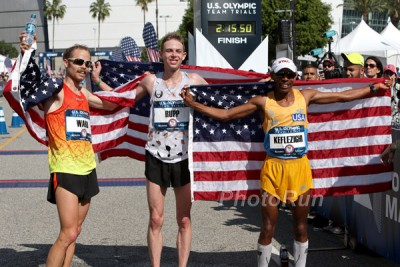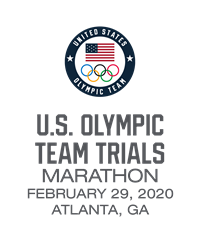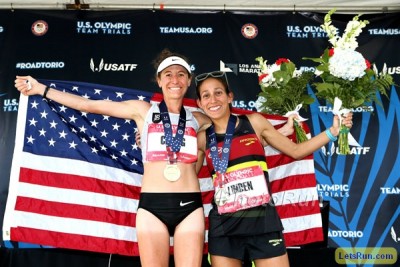Here’s What We Know About the 2020 US Olympic Marathon Trials
By Jonathan Gault
July 8, 2019
The selection policy for the 2020 US Olympic marathon team, cloudy for months after the IAAF announced in March that the qualification process for the 2020 Olympic Games is changing, is quietly beginning to take shape. For those wishing to preserve the best thing about the US Olympic Marathon Trials — top three across the line make the team — there was some good news, but there remains work to be done. After speaking with sources at the IAAF and USATF, here’s where we stand eight months from the Olympic Trials, which will be held in Atlanta on February 29.
The first bit of news trickled out on June 25 in the IAAF Athlete Representative Newsletter, which was promptly shared by agent Dan Lilot on Twitter. The update? After lobbying from USATF, the IAAF Council approved that “national Tokyo 2020 Olympic selection championship/trials in the men’s and/or women’s marathon, held in 2019 or 2020, may be granted Gold Label status if requested by the Member Federations and if the race can meet the Gold Label requirement for number of Gold Label athletes.”
 Normally, Gold Label status is awarded to a marathon based on the previous year’s field. So to attain Gold Label status in 2020, the 2019 edition of the race would have to have six men and six women with Gold Label status that year, or seven athletes if it’s a single-gender race (Gold Label status is awarded to an athlete based on their world ranking at the end of the previous year; a marathoner has to be ranked in the world’s top 200 to earn Gold Label status). The 2019 edition of the US Olympic Marathon Trials would normally be the 2019 USATF Marathon Championships, but USATF isn’t holding a marathon championship this year. So what the IAAF is saying is that USATF doesn’t have to worry about the field at the 2019 USATF Marathon Championships; as long as the Trials has enough Gold Label athletes, it can be granted Gold Label status.
Normally, Gold Label status is awarded to a marathon based on the previous year’s field. So to attain Gold Label status in 2020, the 2019 edition of the race would have to have six men and six women with Gold Label status that year, or seven athletes if it’s a single-gender race (Gold Label status is awarded to an athlete based on their world ranking at the end of the previous year; a marathoner has to be ranked in the world’s top 200 to earn Gold Label status). The 2019 edition of the US Olympic Marathon Trials would normally be the 2019 USATF Marathon Championships, but USATF isn’t holding a marathon championship this year. So what the IAAF is saying is that USATF doesn’t have to worry about the field at the 2019 USATF Marathon Championships; as long as the Trials has enough Gold Label athletes, it can be granted Gold Label status.
This is good news for American women. Remember, an athlete automatically achieves the Olympic standard by finishing in the top five at a Gold Label marathon. And the women’s race at the US Olympic Trials should have no problem hitting the minimum Gold Label requirements; 11 American women had Gold Label status in 2019, and as of the most recent world rankings, 10 are on track to earn it in 2020. That means that on the women’s side, the Olympic Trials will be able to use the “top three make the team” model. (Also note that Japan, which is holding its first Olympic marathon trials in September, will easily meet the criteria on the men’s and women’s side).
That may not sound like a huge deal, considering nine American women already have the Olympic standard. But consider two women who do not have the standard: Amy Cragg and Shalane Flanagan, both members of the 2016 Olympic team. If it’s a bad weather day on the hilly Atlanta course, it’s not out of the question that third place could be slower than the Olympic time standard of 2:29:30 (Flanagan finished third at the ’16 Trials in 2:29:19). Achieving Gold Label status puts any of those worries to bed. That’s a win for USATF.
On the men’s side, USATF still has some work to do. Only one American man, Galen Rupp, qualified for Gold Label status in the marathon in 2019. And right now, Rupp is the only American man on track to earn it again in 2020 (Scott Fauble and Jared Ward are just outside, at #205 and #210 in the current world rankings). That means that, based on the criteria the IAAF announced on June 25, there’s no way that the men’s race at the Olympic Trials will qualify for Gold Label status. And the men are the ones who need it: Fauble and Ward are the only Americans with the Olympic standard, and the time standard of 2:11:30 could be tough to hit on the day in Atlanta.
***
Currently, USATF has a Plan A and a Plan B.
Plan A is what we’ll call the “exemption” model: the IAAF grants an “exemption” or comes up with a new system that guarantees the top 3 at the men’s race at the US Olympic Trials earn the Olympic standard. If granted, USATF could employ its preferred model, the one it has used in previous years: top three finishers make the team. No ifs, ands, or buts.
“We’re continuing to lobby for Gold Label status for both [races at the Trials],” said Michael Scott, chair of USATF’s Long Distance Running (LDR) Division (the men’s and women’s LDR committees are in charge of proposing the Olympic Trials selection process).
Editor’s note: The Trials don’t have to get “Gold” label status, they could just be designated a new label that guarantees races of that caliber get top 3 in the Olympics.
“We have Duffy [Mahoney, USATF Chief of Sport Performance,] working on it,” said Ed Torres, chair of USATF’s Men’s LDR Committee. “We have a few other people trying to find the appropriate channels to get that Gold Label status. Do we know it’s going to happen? No, we don’t know yet, but we’re working on it. As soon as we find out that we do get that status, we’ll let everybody know. That’s what we’re shooting for. That’s what we want. We don’t want to settle for alternatives because I know it doesn’t make for good TV.”
Sources close to the situation are mixed as to whether they believe USATF will be able to work out a solution with the IAAF to ensure the top three finishers in both races at the Trials will be able to go to the Olympics.
“I have my reservations on it,” said Torres. “I know they’re pretty strict and stubborn with how they do things over there (at the IAAF), but the way we plead our case is pretty solid and I feel like they should be listening to what we have to say.”
However, another source told LetsRun that they were optimistic that a deal could be brokered between the two sides.
A third source at the IAAF was less optimistic. The stumbling blocks? The IAAF doesn’t want to be viewed as catering specifically to the US. And if USATF is granted an exemption, other countries not currently holding trials may start their own and demand the same.
Should USATF fail to earn the exemption, Torres said that the plan would be for USATF to move forward with the women’s race earning Gold Label status and the men without it.
“That’s something we asked Duffy to follow up on,” Torres said. “If there’s a situation where the women can get Gold status and [the men] unfortunately can’t get it, I’m all for it. I want to make sure that the show that’s going to be produced is very simple, plain and simple. I’ll support the women to be Gold Label status even [if] the men can’t get that status.”
***
So what if the IAAF fails to grant USATF an exemption on the men’s side? Then it’s time for Plan B.
The current Plan B, as proposed by the LDR committees, would call for USATF to select the top three finishers at the Trials who either a) have the Olympic standard or b) would be in a strong position to earn a bid from the IAAF via its World Rankings.
What constitutes a strong position?
“We’re trying to figure this out, what number to use,” Torres said. “That’s why we haven’t put out our criterium yet.”
According to TokyoRankings.com, a site that uses the IAAF’s World Rankings to track which athletes are in line for selection for the 2020 Olympics, any American man ranked in the top 403 in the world right now would be in position to earn an invitation from the IAAF, which will use the World Rankings to fill the 80-man Olympic marathon field after accounting for athletes with the auto standard. But USATF may require an athlete to be ranked higher than that to make sure that any athlete it names to the team will actually earn a bid from the IAAF.
“We want to be conservative with the number to make sure our guys are getting in,” Torres said. “We don’t want to get a guy who’s ranked [as the] 78th [man in] and award him a decision just in case he gets bumped off the rankings by the end of the closing date of the window.”
The qualification window for the marathon closes on May 31, 2020. Torres said that, under the current LDR proposal, if an athlete without the standard finishes in the top three, USATF may name him to the team but make him run a half marathon before May 31 to improve his marathon World Ranking and cement his position (HM performances can be used to earn World Ranking points in the marathon).
If this all seems overly complicated…well, it is. Why can’t USATF just go to the IAAF and say: Here are the results of our trials. We want to make sure that the three highest-placing athletes in position to receive a bid are named to the team. If third place isn’t ranked high enough to earn a bid, we want to name fourth place. If fourth place isn’t ranked high enough, we want to name fifth place. Etc.
“I’m not gonna answer that because there are some legal issues that could possibly happen if we open up that can of worms just because some athlete could say, Why are you skipping me?” Torres said.
Unless the men’s race is granted an exemption, Torres admitted that the simplicity of recent Trials will be gone. In 2016, the men’s Olympic standard of 2:19:00 was soft enough that anyone with an outside shot of making the team could run it, allowing for the “top three make the team” model that creates simple, understandable stakes for casual fans watching on TV. Any solution that involves USATF including the World Rankings — something LDR wants to do, based on the feedback it has received from athletes and coaches — will make following the race on television more difficult. Even if it results in a fairer team.
“[Incorporating the World Rankings] is not great for TV because that’s going to be impossible to explain,” Torres said. “The wrench that they threw us, that’s essentially where we’re at right now. It’s a horrible way to explain. It’s impossible. For us, even you and me speaking, there’s some confusion, right? Try to make that simple for everybody else to understand that. It’s going to be pretty tough.”
One more question: why did USATF tell LetsRun back in March that USATF wouldn’t use the World Rankings and would be picking the top three finishers with the Olympic standard in each race, creating confusion that festered for months?
A USATF source with knowledge of the situation finally provided some clarity. The explanation? Every recent World/Olympic team has used the “top three with the standard” model. So when LetsRun asked the USATF communications department for a statement, USATF defaulted to that explanation, even though no official selection policy had been approved yet.
“The men’s and women’s LDR committee had no policy in place,” the source said. “The national office’s point of view is that we have always had the first three with the entry standard. That is what it has historically been but it had not been approved or discussed by men’s and women’s LDR.”
USATF has made progress toward the outcome the majority of the American distance community wants to see: the top three finishers at the Trials representing Team USA in Tokyo. On the women’s side, this outcome is now all but assured. On the men’s side, USATF will continue to fight for an exemption, and do the best it can from there if it fails. It’s going to be an interesting eight months.
Previously from LetsRun.com
LRC The Olympic Marathon Trials Are (Still) In Jeopardy — Here’s What USATF & the IAAF Can Do to Fix It
LRC One Week Later: How Will USATF Select the 2020 Olympic Team? No One Really Seems to Know


